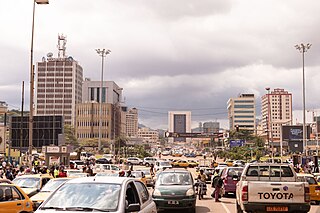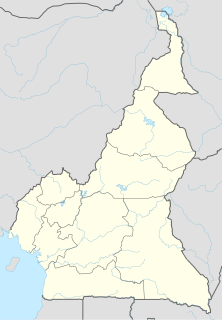
The Western Front was the main theatre of war during the First World War. Following the outbreak of war in August 1914, the German Army opened the Western Front by invading Luxembourg and Belgium, then gaining military control of important industrial regions in France. The tide of the advance was dramatically turned with the Battle of the Marne. Following the Race to the Sea, both sides dug in along a meandering line of fortified trenches, stretching from the North Sea to the Swiss frontier with France, which changed little except during early 1917 and in 1918.

Yaoundé is the capital of Cameroon and, with a population of more than 2.8 million, the second-largest city in the country after the port city Douala. It lies in the Centre Region of the nation at an elevation of about 750 metres (2,500 ft) above sea level.

Imperial War Museums (IWM) is a British national museum organisation with branches at five locations in England, three of which are in London. Founded as the Imperial War Museum in 1917, the museum was intended to record the civil and military war effort and sacrifice of Britain and its Empire during the First World War. The museum's remit has since expanded to include all conflicts in which British or Commonwealth forces have been involved since 1914. As of 2012, the museum aims "to provide for, and to encourage, the study and understanding of the history of modern war and 'wartime experience'."

German Cameroon was an African colony of the German Empire from 1884 to 1916 in the region of today's Republic of Cameroon. German Cameroon also included northern parts of Gabon and the Congo with western parts of the Central African Republic, southwestern parts of Chad and far eastern parts of Nigeria.

The Bight of Biafra is a bight off the West African coast, in the easternmost part of the Gulf of Guinea.

A war artist is an artist who depicts scenes or aspects of war through their art. The art might be a pictorial record, or it might commemorate how war shapes lives. War artists explore the visual and sensory dimensions of war, often absent in written histories or other accounts of warfare.

The History of the Great War Based on Official Documents by Direction of the Committee of Imperial Defence is a series of 109 volumes, concerning the war effort of the British state during the First World War. It was produced by the Historical Section of the Committee of Imperial Defence from 1915 to 1949; after 1919 Brigadier-General Sir James Edmonds was Director. Edmonds wrote many of the army volumes and influenced the choice of historians for the navy, air force, medical and veterinary volumes. Work had begun on the series in 1915 and in 1920, the first volumes of Naval Operations and Seaborne Trade, were published. The first "army" publication, Military Operations: France and Belgium 1914 Part I and a separate map case were published in 1922 and the final volume, The Occupation of Constantinople was published in 2010.

Imperial War Museum Duxford is a branch of the Imperial War Museum near Duxford in Cambridgeshire, England. Britain's largest aviation museum, Duxford houses the museum's large exhibits, including nearly 200 aircraft, military vehicles, artillery and minor naval vessels in seven main exhibition buildings. The site also provides storage space for the museum's other collections of material such as film, photographs, documents, books and artefacts. The site accommodates several British Army regimental museums, including those of the Parachute Regiment and the Royal Anglian Regiment.

The Hundred Days Offensive was an Allied offensive which ended the First World War. Beginning with the Battle of Amiens on the Western Front, the Allies pushed Central Powers back after their gains from the Spring Offensive. The Germans eventually retreated to the Hindenburg Line, culminating in the Armistice of 11 November 1918. The term "Hundred Days Offensive" does not refer to a battle or strategy, but rather the rapid series of Allied victories against which the German armies had no reply.

The Churchill War Rooms is a museum in London and one of the five branches of the Imperial War Museum. The museum comprises the Cabinet War Rooms, a historic underground complex that housed a British government command centre throughout the Second World War, and the Churchill Museum, a biographical museum exploring the life of British statesman Winston Churchill.

Edward Bawden, (1903–1989) was an English painter, illustrator and graphic artist, known for his prints, book covers, posters, and garden metalwork furniture. Bawden taught at the Royal College of Art, where he had been a student, worked as a commercial artist and served as a war artist in World War Two. He was a fine watercolour painter but worked in many different media. He illustrated several books and painted murals in both the 1930s and 1960s. He was admired by Edward Gorey, David Gentleman and other graphic artists, and his work and career is often associated with that of his contemporary Eric Ravilious.

The African Theatre of World War I describes campaigns in North Africa instigated by the German and Ottoman empires, local rebellions against European colonial rule and Allied campaigns against the German colonies of Kamerun, Togoland, German South West Africa and German East Africa which were fought by German Schutztruppe, local resistance movements and forces of the British Empire, France, Italy, Belgium and Portugal.
Cyril Bentham Falls CBE was a 20th Century British military historian, journalist and academic, noted for his works on the First World War.
Max Arthur OBE is an oral and military historian and author who specialises in first-hand recollections of the twentieth century in particular the First and Second World War. His most noted work is 'Forgotten Voices of the Great War' and 'Forgotten Voices of the Second World War' both in association with the Imperial War Museum.

Monmouth Castle is a castle in the town of Monmouth, county town of Monmouthshire, south east Wales. It is a Grade I listed building and scheduled monument.
British official war artists were a select group of artists who were employed on contract, or commissioned to produce specific works during the First World War, the Second World War and select military actions in the post-war period. Official war artists have been appointed by governments for information or propaganda purposes and to record events on the battlefield; but there are many other types of war artist.

The Togoland Campaign was a French and British invasion of the German colony of Togoland in west Africa, which began the West African Campaign of the First World War. German colonial forces withdrew from the capital Lomé and the coastal province, to fight delaying actions on the route north to Kamina, where the Kamina Funkstation linked the government in Berlin to Togoland, the Atlantic and South America. The main British and French force from the neighbouring colonies of Gold Coast and Dahomey, advanced from the coast up the road and railway, as smaller forces converged on Kamina from the north. The German defenders were able to delay the invaders for several days at the battles of Agbeluvhoe and Chra but surrendered the colony on 26 August 1914. In 1916, Togoland was partitioned by the victors and in July 1922, British Togoland and French Togoland were established as League of Nations mandates.

The Battle of Beleaguer, also known as the Battle of Tsewie, was fought during the First World War between invading British Empire soldiers of the West African Rifles and German troops in German Togoland on 15 August 1914. British troops at the Togolese capital Lomé on the coast, had advanced towards a wireless station at Kamina, 100 mi (160 km) inland on hills near Atakpame. The only routes inland were by the railway and road, which had been built through dense and almost impassable jungle.

The Kamerun Campaign took place in the German colony of Kamerun in the African theatre of the First World War when the British, French and Belgians invaded the German colony from August 1914 to March 1916. Most of the campaign took place in Kamerun but skirmishes also broke out in British Nigeria. By the Spring of 1916, following Allied victories, the majority of German troops and the civil administration fled to the neighbouring neutral colony of Spanish Guinea. The campaign ended in a defeat for Germany and the partition of its former colony between France and Britain.

This article is about the Delville Wood order of battle. The Battle of Delville Wood was fought from 14 July – 3 September 1916, one of the engagements of the Battle of the Somme. It was fought between Allied forces and the German Empire in the Somme River valley in northern France. The battle was the début of the 1st South African Brigade on the Western Front, which captured Delville Wood and held it from 15–19 July. The casualties of the brigade were similar to those of many British brigades on 1 July 1916. Delville Wood is well preserved with the remains of trenches, a museum and monument to the 1st South African Brigade. After the relief of the South Africans the battle for the wood continued until the end of August, when the last German footholds were captured by the 43rd Brigade of the 14th (Light) Division on 27 August. A large German counter-attack on 31 August regained part of the north edge of the wood until British attacks from 4–8 September, which secured the wood until the battles of 1918.

















